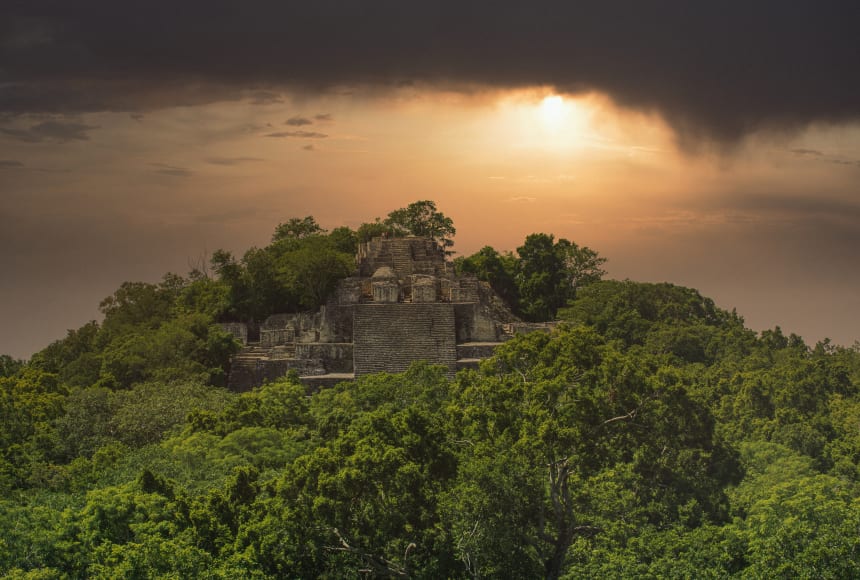Researchers are hailing a "major breakthrough" in Maya archaeology. They have identified the ruins of more than 60,000 houses, palaces, highways and other human-made features, hidden for centuries under the jungles of northern Guatemala.
The discovery was made using a revolutionary technology known as LiDAR, short for Light Detection And Ranging. A LiDAR system on a satellite or plane uses its lasers to measure distances to Earth. These light pulses combined with other data recorded by the system create a 3-D image of the ground. With LiDAR, researchers removed the tree canopy from aerial images of the landscape, revealing the ruins of a vast pre-Columbian civilization. These ruins were far more complex and interconnected than most Maya specialists had thought.
Population Underestimated
"The LiDAR images make it clear that this entire region was a settlement system whose scale and population density had been grossly underestimated," Thomas Garrison said. The Ithaca College archaeologist and National Geographic Explorer uses digital technology in his research.
Garrison is part of a consortium of researchers who are participating in the project, which was spearheaded by the PACUNAM Foundation. The Guatemalan nonprofit fosters long-term scientific research and development, and works to preserve the cultural heritage of the region.
The project mapped more than 2,100 square kilometers (800 square miles) of the Maya Biosphere Reserve in Guatemala. The number of aerial images in the LiDAR data set is the largest ever obtained for archaeological research.
Advanced Civilization
The results suggest that Central America supported an advanced civilization. Previous ground-based studies had compared the Maya civilization to scattered and sparsely populated city-states. Current research indicates that at the peak of this civilization, some 1,200 years ago, the Maya could be compared to sophisticated cultures such as ancient Greece or China.
LiDAR images also revealed highways connecting urban centers and mining quarries. Complex irrigation and terracing systems supported intensive agriculture, as workers dramatically reshaped the landscape.
The ancient Maya never used the wheel or beasts of burden, like donkeys and mules. Yet "this was a civilization that was literally moving mountains," said Marcello Canuto, a Tulane University archaeologist and National Geographic Explorer who participated in the project.
Complex Societies May Have Formed in Tropics
"We've had this western conceit that complex civilizations can't thrive in the tropics, that the tropics are where civilizations go to die," Canuto said. He conducts archaeological research at a Guatemalan site known as La Corona. "But with the new LiDAR-based evidence from Central America ... and [Cambodia's] Angkor Wat, we now have to consider that complex societies may have formed in the tropics and made their way outward from there."
"LiDAR is revolutionizing archaeology the way the Hubble Space Telescope revolutionized astronomy," said Francisco Estrada-Belli, a Tulane University archaeologist and National Geographic Explorer. Researchers will need at least a century to look through and understand all the data.
Twice the Size of England but More Densely Populated
Already, though, the survey has yielded surprising insights into settlement patterns, interurban connectivity and militarization in the Maya Lowlands. During the Maya classic period, about 1,100 to 1,800 years ago, the civilization covered an area about twice the size of medieval England, and it was far more densely populated.
"Most people had been comfortable with population estimates of around five million," Estrada-Belli said. "With this new data, it's no longer unreasonable to think that there were 10 miillion to 15 million people there," including in many swampy areas previously believed to be uninhabitable.
Virtually all the Maya cities were connected by wide roadways allowing for heavy traffic, trade and other kinds of regional communication. When cities saw too much or little rain, the flow of water was carefully controlled with canals, dikes, and reservoirs. Highways were elevated to allow for easy travel even during rainy seasons.
Among the most surprising findings was the ubiquity of defensive walls, ramparts, terraces, and fortresses. "Warfare wasn't only happening toward the end of the civilization," Garrison said. "It was large-scale and systematic, and it endured over many years."
The survey also revealed thousands of pits dug by modern-day looters. "Many of these new sites are only new to us; they are not new to looters," said Marianne Hernandez, president of the PACUNAM Foundation.
Environmental degradation is a concern, as Guatemala loses more than 10 percent of its forests annually, and habitat loss has accelerated along its border with Mexico as trespassers burn and clear land for agriculture and human settlement.
Raising Awareness
Researchers want to identify and understand these sites to "raise awareness of the value of protecting these places," Hernandez said.
The survey is the first phase of the PACUNAM LiDAR Initiative, a three-year project that will map more than 14,000 square kilometers (5,000 square miles) of Guatemala's lowlands. Extending north to the Gulf of Mexico, the lowlands were an important part of pre-Columbian settlements.
"The ambition and the impact of this project is just incredible," said Kathryn Reese-Taylor, a University of Calgary archaeologist and Maya specialist who was not associated with the PACUNAM survey. "After decades of combing through the forests, no archaeologists had stumbled across these sites. More importantly, we never had the big picture that this data set gives us. It really pulls back the veil and helps us see the civilization as the ancient Maya saw it."

